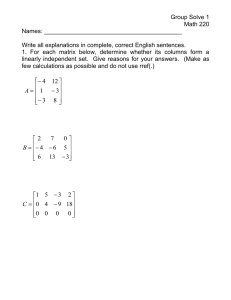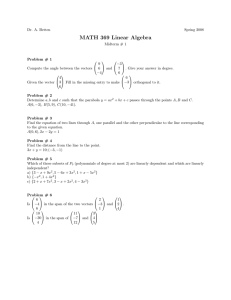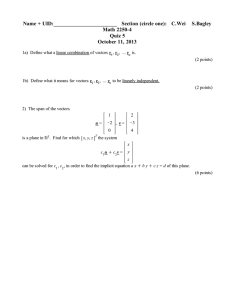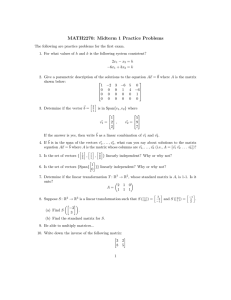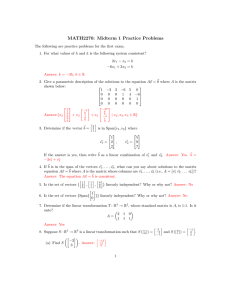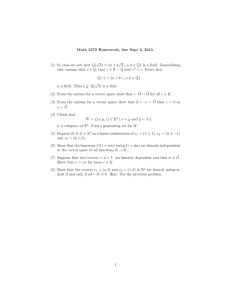Sec. 4.3 Linearly Independeent Sets and Bases.doc
advertisement
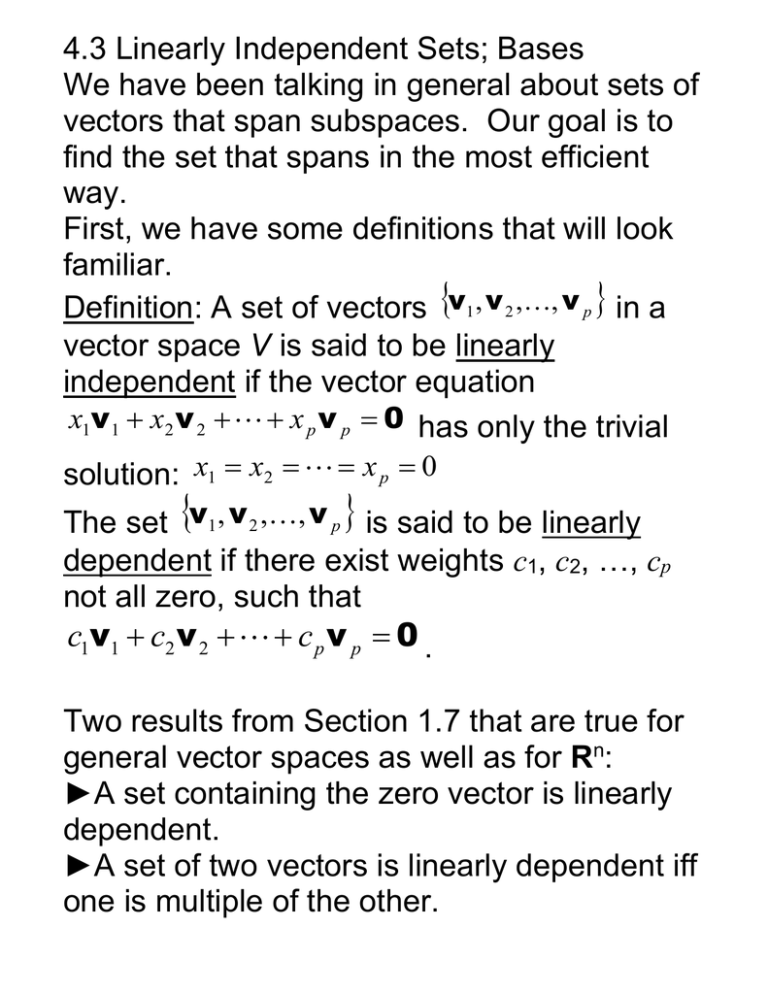
4.3 Linearly Independent Sets; Bases
We have been talking in general about sets of
vectors that span subspaces. Our goal is to
find the set that spans in the most efficient
way.
First, we have some definitions that will look
familiar.
Definition: A set of vectors v1 , v 2 ,, v p in a
vector space V is said to be linearly
independent if the vector equation
x1v1 x2 v 2 x p v p 0 has only the trivial
solution: x1 x2 x p 0
The set v1 , v 2 ,, v p is said to be linearly
dependent if there exist weights c1, c2, …, cp
not all zero, such that
c1v1 c2 v 2 c p v p 0 .
Two results from Section 1.7 that are true for
general vector spaces as well as for Rn:
►A set containing the zero vector is linearly
dependent.
►A set of two vectors is linearly dependent iff
one is multiple of the other.
►The main difference between linear
dependence in Rn and in a general vector
space is that when vectors are not n-tuples,
the homogeneous equation Ax = 0 usually
cannot be written as a system of linear
equations.
Example:
1 2 0 0 3 3
,
,
is a linearly dependent
3 4 0 0 2 0
set since it contains the zero vector of M2x2.
Example:
1 2 3 9
,
3 4 6 11
Is this set linearly independent or linearly
dependent?
There are two vectors and they one is not a
scalar multiple of the other: look at the first
row to see that in the (1, 1)-entry 3(1) = 3, but
in the (2, 2)-entry 3(2) ≠ 9. Thus, the set is
linearly independent. .
Theorem 4.4: An indexed set, v1 , v 2 ,.., v p of
two or more vectors, with v1 0 is linearly
dependent if and only if some vector v j
(j > 1) is a linear combination of the preceding
vectors v1 , v 2 ,.., v j 1 .
Example: Let p1 , p 2 , p3 be the set of vectors
2
p
t
t
p
t
t
in P2 where 1
, 2
, and
p 3 t 4t 2t 2 .
Are these vectors linearly independent or
linearly dependent?
Since p3 4p1 2p2 , p3 is a linear combination
of p1 and p2, the vectors are linearly
dependent.
A Basis Set
Let H be the plane illustrated below.
Which of the following are descriptions of H?
a) H Spanv1, v 2
b) H Spanv1 , v 3
c) H Spanv 2 , v 3
d) H Spanv1 , v 2 , v 3
A basis set is an efficient spanning set
containing no unnecessary vectors. In this
case, we would consider both the linearly
independent sets v1, v 2 and v1 , v 3 to be
examples of basis sets or bases (plural of
basis) for H.
Definition: Let H be a subspace of a vector
space V. An indexed set of vectors
b1 , b 2 ,.., b p in V is a basis for H if
i) β is a linearly independent set, and
ii) H = Span{b1, b2, …, bp}.
Example: Let
0
1
0
0
e
e1 0 e 2 1
3
1 .
0 ,
0 ,
The IMT shows that {e1, e2, e3} is a basis for
R3 .
Let
A e1 e 2
1 0 0
e3 0 1 0
0 0 1 .
Since A has 3 pivots, the columns of A are
linearly independent by the IMT, and the
columns of A span R3 also by IMT.
Therefore, {e1, e2, e3} is a basis for R3.
The set {e1, e2, e3} is called the standard
basis for R3.
Example: Let S = {1, t, t2, …, tn}.
Show that S is a basis for Pn.
Proof: Any polynomial in Pn is in SpanS since
every polynomial of degree at most n has the
n
c
1
c
t
...
c
t
1
n
form 0
with ci R.
To show that S is linearly independent,
assume
c0 1 c1 t ... cn t n 0 ,
(the zero polynomial).
Then c0 c1 ... cn 0 .
Hence, S is a basis for Pn.
This is the standard basis for Pn.
Example: Let
1
0
1
v1 2 v 2 1 v 3 0
3 .
1 ,
0 ,
Is {v1, v2, v3} a basis for R3?
Let
A v1 v 2
1 0 1
v 3 2 1 0
0 1 3 .
We want to know how many pivots A has.
Using the row operations: -2R1 + R2
1 0 1
0 1 2
0 1 3
-R2 + R3
1 0 1
0 1 2
0 0 5
Since A is a 3x3 matrix with 3 pivots, the
columns of A are linearly independent by the
IMT, and the columns of A span R3 also by
IMT.
Therefore, {v1, v2, v3} is a basis for R3.
Examples:
Explain why each of the following sets is not
a basis for R3.
(a)
1 4 0 1
2, 5, 1, 3
3 7 0 7
more vectors than entries in each vector, so
the set is not linearly independent.
(b)
1 4
2 , 5
3 6
1 4
A 2 5
Let
3 6
Since there is not a pivot in every row of A, its
columns don’t span R3 by the Theorem 1.4.
Example: Find a basis for Nul A where
3 6 6 3 9
A
6
12
13
0
3
We showed in Section 4.2 that we can write
Nul A as the span of three vectors:
Row reduce [A 0] to get
1 2 0 13 33 0
0 0 1 6 15 0
The solution is:
x1 2 x2 13 x4 33 x5
x
x
2
2
x3
6 x4 15 x5
x4
x4
x5
x5
2
13
33
1
0
0
x2 0 x4 6 x5 15
0
1
0
0
0
1
Let the vectors in the linear combination be u,
v, and w respectively.
Then, Nul A = Span{u, v, w}
This is a basis for Nul A since the vectors are
linearly independent as shown in section 4.2.
The Spanning Set Theorem:
The Idea: A basis can be constructed from a
set of spanning vectors by discarding vectors
which are linear combinations of preceding
vectors in the indexed set.
Example: Suppose
1
0
2
v1 , v 2 , v 3
0
1
3
If x Spanv1 , v 2 , v 3 , then there exist
weights c1, c2, c3 such that
x c1v1 c2 v 2 c3 v 3
Since v 3 2v1 3v 2 , we can rwrite
x c1 v1 c2 v 2 c3 2v1 3v 2
c1 2c3 v1 c2 3c3 v 2
So, we throw out v3 and get
Spanv1 , v 2 , v 3 Spanv1 , v 2
Theorem 4.5: The Spanning Set Theorem
Let S = {v1, v2, …, vp} be a set in V and H =
Span{v1, v2, …, vp}.
a. If one of the vectors in S, say vk, is a
linear combination of the remaining
vectors in S, then the set formed from
S by removing vk still spans H.
b. If H ≠ {0}, some subset of S is a basis
for H.
Example: Basis for a Col A
Let
1 2 0 4
2 4 1 3
A a1 a 2 a3 a 4
3 6 2 22
4 8 0 16
To see what is going on use RREF to change
A into B.
1 2 0 4
0 0 1 5
B b1 b 2 b3 b 4
0 0 0 0
0 0 0 0
Now it is easy to see b2 2b1 ,
b 4 4b1 5b3 and
b1 and b3 are not multiples of each other.
Note: a2 2b1 , a4 4a1 5a3 and
a3 are not multiples of each other.
a1
and
►Elementary row operations on a matrix do
not change the linear dependence relations
among the columns.
So, Span{a1, a2, a3, a4} = Span{a1, a3 }
And {a1, a3 } is a basis for Col A.
This is an example of Theorem 6.
Theorem 4.6: The pivot columns of a matrix A
form a basis for Col A.
Example:
1
2
3
v1 2 , v 2 4, v 3 6
3
6
9
Find a basis for Span{v1, v2, v3}. Let
1 2 3
A 2 4 6
3 6 9
and note that Col A = Span{v1, v2, v3}.
RREF gives
1 2 0
A ~ 0 0 1
0 0 0 .
Thus, columns 1 and 3 are linearly
independent, so Col A = Span{v1, v3}
1 3
Span 2 , 6
3 9
Review:
1. To find a basis for Nul A, use elementary
row operations to transform [A 0] to an
equivalent reduced row echelon form [B 0].
Use the rref to find the parametric form of the
general sol’n to Ax = 0.
The vectors in the parametric form form a
basis for Nul A.
2. A basis for Col A is formed from the pivot
columns of A.
Warning: Use the pivot columns of A, not the
pivot columns of B where B is the rref of A.
The Invertible Matrix Theorem:
Let A be a square n x n matrix. The following
statements are equivalent.
a. A is an invertible matrix.
b. A is row equivalent to In.
c. A has n pivot positions.
d. The equation Ax = 0 has only the trivial
solution.
e. The columns of A form a linearly
independent set.
f. The linear transformation x → Ax is one-toone.
g. The equation Ax = b has at least one
solution for each b in Rn.
h. The columns A span Rn.
i. The linear transformation x → Ax maps Rn
onto Rn.
j. There is an n x n matrix C s.t.
CA I n .
k. There is an n x n matrix D s.t.
AD I n .
